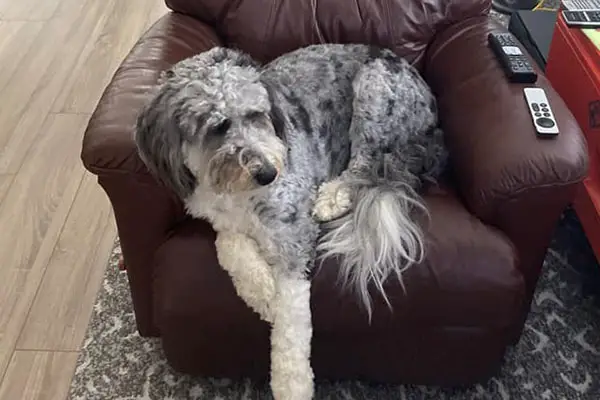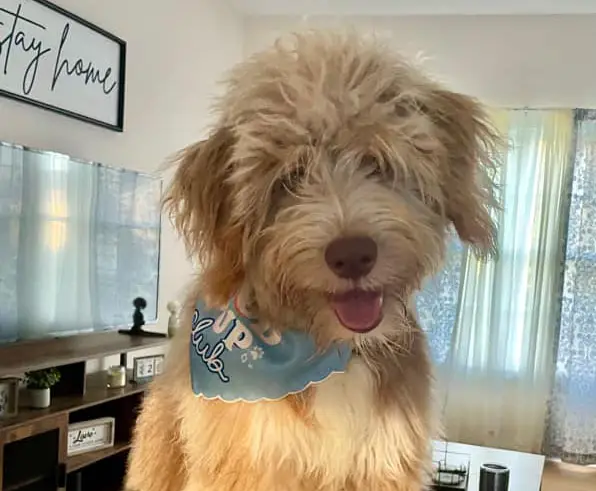Does your Aussiedoodle suddenly smell really bad? Are you struggling to figure out the reason behind this strange new odor? You are in the right place! In this article, I’ll go through some of the reasons why your Aussiedoodle may smell bad. And, more importantly, how to make it smell better.

So, why does your Aussiedoodle smell bad?
There are many reasons why your Aussiedoodle might smell. It may be a health-related issue, which can cause excess sebum production or flatulence. It may also be as simple as not bathing your Aussiedoodle often enough, or not bathing them correctly.
Let’s look at some of the causes of a bad smell in your Aussiedoodle in detail so that you can identify your problem.
Related: Are Aussidoodles Hypoallergenic: Do They Shed? | Aussiedoodle Health Problems | Do Aussiedoodles Have a Tail? Answered!
Why Aussiedoodle Smells
It’s Dirty!
This may seem like a very simple and obvious reason why your Aussideoodle stinks. But it is not always clear to those who have not owned an Aussiedoodle before.
The Aussiedoodle has varying coat types. Some are more Poodle-like, with thick curls that hold onto dirt. If your Aussiedoole is like one of these, it may be more obvious when it is time for a bath.
However, if your Aussiedoodle has a coat more like an Australian Shepherd’s, the dirt may fall off the dog once it has dried. This means that the dog may look clean, even though it isn’t.
Related: Aussiedoodle Generations Explained
As a general rule, you should be bathing your Aussiedoodle once a month. You can push it to six weeks if their coat is straighter and silkier, but no more than that.
Also, ensure that you bathe your Aussiedoodle correctly when you do bathe it. You need to clean all of the fur, as well as the actual skin. Otherwise, you may leave foul-smelling dirt behind.
Excess Sebum
Sebum is a substance produced by the skin of most animals. It is oily and serves a variety of purposes, including protecting the skin from infections. However, it can smell if there is too much of it.
There are a variety of reasons why your Aussiedoodle dog may have excessive sebum on its skin and in its coat. It could be that you are not washing it with the correct shampoo. Maybe you are not getting all the way down to the skin when it is given a bath.
Or, it might be that your Aussiedoodle is just producing too much sebum.
This is usually due to a hormonal issue, which Poodles and Poodle-hybrids are more prone to. It may also be due to an allergic reaction or to counteract dry skin.
Identifying excessive sebum may be difficult as the smell varies greatly. Instead, it may be easier to identify by examining your dog’s coat and running your finger through it.
If it seems excessively oily, and a smelly residue is left on your hands, then your Aussiedoodle may smell due to sebum.

Dietary Issues and Smelly Food
Sebum may not have to be overproduced in order for it to cause a funny smell in your Aussiedoodle.
The oil secreted on your Aussiedoodle’s skin is greatly affected by what it eats.
If your Aussiedoodle suddenly smells, consider whether you have recently changed its food.
If your dog is on a raw food diet, introducing a new type of meat or vegetable might affect your dog’s scent. If you use kibble, the cause might be a low-quality ingredient. Often it is in whatever is making up the carbohydrate portion of the kibble.
Additionally, a change in food may cause flatulence in your Aussiedoodle. This flatulence may make it seem like the entire dog stinks when it is not necessarily the case.
Fungal and Bacterial Skin Infections
Any fungus or bacterial infection on your Aussiedoodle’s skin may be causing it to smell. This is because the fungus and bacteria let off byproducts such as certain gasses which may have an odor.
Depending on the type of bacteria or fungus, the smells may differ. It may be yeast-like or moldy. In my experience, the scent may even be quite sour.
Usually, identifying a fungal or bacterial skin infection in your Aussiedoodle is very easy. Once you find the origin of the smell, examine the skin itself. If anything seems abnormal – red, flaky, wrinkly, etc. – your Aussiedoodle probably has a skin infection and needs to be treated by a vet.

Ear Infections
Although the smell might seem to be permeating from everywhere, upon further investigation you might find that it is originating from the ears. Aussiedoodles can have adorable, floppy ears. Unfortunately, these may be prone to infections, because moisture can gather in them.
Bacterial infections in the ears may smell just like bacterial infections in the skin. They may be sweet, or they may be sour. They may even smell a bit like cheese.
If your Aussiedoodle has an ear infection, it will probably be quite painful. Your Aussiedoodle may scratch at the ear, or try to rub it on other items to relieve any pain and itching.
An ear infection can also cause discharge in the ear, which can aid in identification.
Related: Do Aussiedoodles Like Swimming? Answered!
Anal Gland Issues
Most of the time, it is impossible to smell the scent given off by anal glands. Instead, the scent is used to communicate with other dogs.
But, if you notice that your dog suddenly smells fishy, it might be a sign that there is something wrong with them.
Most of the time, these issues are not serious. It may simply be that your Aussiedoodle’s anal glands can no longer express themselves due to a variety of factors, such as old age.
In cases like this, they will need to be manually expressed about once a month. You can do this yourself. Some groomers do it as well, provided that you ask for it. Or you can see your vet.
It is always best to get the issue checked out to make sure that there is nothing more going on, such as a tumor.
Other symptoms of anal gland issues might be discomfort. Your Aussiedoodle might ‘scoot’ its rear end on grass or carpet. It may also lick at the area.
Dental Decay
Humans get bad breath if they don’t brush their teeth. Dogs, including Aussiedoodles, are pretty much the same.
If there is a problem with something in your Aussiedoodle’s mouth, it may cause a bad scent. This will generally smell like rotting meat.
If the smell appears suddenly and then goes away, it is probably just something that your dog ate. But if you are worried that it might be a decaying tooth or periodontal disease, there are some other indicators that you can use to identify a problem.
First, look for staining on the teeth. This could be yellow, but it may also be brown, or even black.
Gums should be a pale pink color most of the time. If they seem to be a very dark red or are bleeding in some places, it may be a sign of gum disease.

How to Make an Aussiedoodle Smell Better
Identify the Problem
The first step to improving the scent of your Aussiedoodle is to identify what is causing the bad smell.
If it is something like dental decay or any form of infection, the only solution is probably going to be to take your dog to the vet. The reason for this is that the vet will likely have to run tests to determine what the bacteria or fungus is, in order to prescribe the correct antibiotic.
In cases of dental decay, the dog may have to endure anesthesia for a deep clean or even an extraction.
The vet will also be able to advise you on any anal gland issues.
Frequent Bathing
If you do not think that there is anything wrong with your dog’s skin, but it seems to stink all the time, consider more frequent bathing.
The skin of every dog may differ, so some will need excess sebum removed more frequently than others.
Correct Bathing Technique
There is no use bathing your dog more often if you do not wash it properly. If you do not get whatever stinks off your Aussiedoodle, then you may as well not have washed it at all.
Make sure that you wet your Aussiedoodle thoroughly before applying the shampoo.
Once the shampoo is on, make sure that you get it right against the skin as this is where most oils and dirt will be.
You can do this by raking your fingers through the fur, and massaging the shampoo in with the tips of your fingers.
Make sure that you wash the hard-to-reach places of your Aussiedoodle, such as underneath them. If you struggle to get enough water in these areas to spread your shampoo, consider getting a pet wand.
Make sure that you rinse your Aussiedoodle thoroughly afterward too. Leaving shampoo on your dog can cause dry skin, making it more prone to infections.
Correct Shampoo
Using the wrong shampoo can be detrimental to your Aussiedoodle.
It can dry out the skin, leading to an increased prevalence of bacterial and fungal infections, as mentioned above. It can also lead to an allergic reaction, which may cause an increase in sebum production and a resulting bad smell.
Although there is no way to say that one shampoo is suitable for all dogs, it is best to try a hypoallergenic shampoo with an oatmeal base. These will not dry out your Aussiedoodle’s skin and will be less likely to cause a bad reaction.
Related Reading:
- Aussiedoodle Temperament Guide: Australian Shepherd Poodle Mix
- How Big Will An Aussiedoodle Get (Size and Weight)
- Average Life Expectancy of Aussiedoodle Dog (Toy, Mini, Standard)
- Do Aussiedoodles Bark A Lot? Answered!
- Are Aussiedoodles Protective: Do They Make Good Guard Dogs?
- How Much Exercise Does an Aussiedoodle Need?
- Is a Male or Female Aussiedoodle Better?
